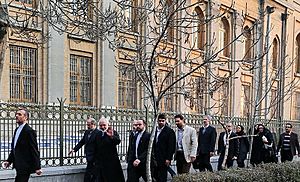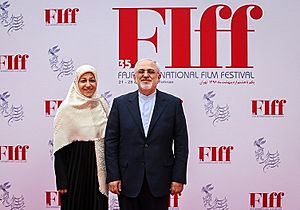Mohammad Javad Zarif facts for kids
Quick facts for kids
Mohammad Javad Zarif
|
|
|---|---|
|
محمدجواد ظریف
|
|
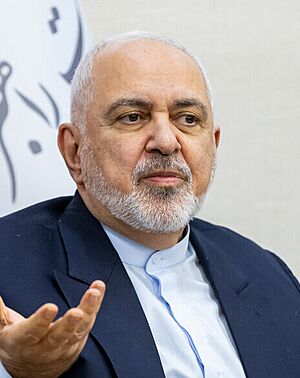
Zarif in 2025
|
|
| Vice President of Iran for Strategic Affairs |
|
| In office 1 August 2024 – 2 March 2025 |
|
| President | Masoud Pezeshkian |
| Preceded by | Position established |
| Succeeded by | Mohsen Esmaeili |
| Advisor to the President of Iran Head of Center for Strategic Studies |
|
| In office 1 August 2024 – 2 March 2025 |
|
| President | Masoud Pezeshkian |
| Preceded by | Mostafa Zamanian |
| Succeeded by | Mohsen Esmaeili |
| Minister of Foreign Affairs of Iran | |
| In office 15 August 2013 – 25 August 2021 |
|
| President | Hassan Rouhani |
| Deputy | Morteza Sarmadi |
| Preceded by | Ali Akbar Salehi |
| Succeeded by | Hossein Amir-Abdollahian |
| Chief Nuclear Negotiator of Iran | |
| In office 6 September 2013 – 14 July 2015 |
|
| President | Hassan Rouhani |
| Deputy | Abbas Araghchi |
| Preceded by | Saeed Jalili |
| Succeeded by | Abbas Araghchi (as head of JCPOA follow-up commission) |
| Ambassador of Iran to the United Nations | |
| In office 5 August 2002 – 25 July 2007 |
|
| President | Mohammad Khatami Mahmoud Ahmadinejad |
| Preceded by | Mohammad Hadi Nejad Hosseinian |
| Succeeded by | Mohammad Khazaee |
| Personal details | |
| Born | 8 January 1960 Tehran, Pahlavi Iran |
| Political party | Independent |
| Spouse |
Maryam Imanieh
(m. 1979) |
| Children | 2 |
| Awards | see below |
| Signature |  |
| Website | Government site |
| Alma mater | San Francisco State (BA, MA) University of Denver (MA, PhD) |
| Scientific career | |
| Institutions | School of International Relations University of Tehran Islamic Azad University |
| Thesis | Self-Defense in International Law and Policy (1988) |
Mohammad Javad Zarif (born 8 January 1960) is an Iranian diplomat and professor. He held important roles in the Iranian government. From 2013 to 2021, he was the Foreign Minister of Iran. More recently, he served as the Vice President for Strategic Affairs from August 2024 to March 2025.
As Foreign Minister, Zarif led Iran's talks with a group of world powers known as the P5+1. These talks resulted in a major agreement called the Joint Comprehensive Plan of Action (JCPOA) in 2015. This agreement helped lift some economic penalties against Iran.
Zarif has also been a visiting professor at the School of International Relations and University of Tehran. He taught about diplomacy and international organizations. He was also Iran's Ambassador to the United Nations from 2002 to 2007.
Contents
Early Life and Education
Zarif was born in Tehran, Iran, around 1960. He came from a wealthy and religious family. His father was a well-known businessman.
He attended the Alavi School, a private religious school. As a young person, he learned about revolutionary ideas by reading books.
At age 17, Zarif moved to the United States. He went to Drew College Preparatory School in San Francisco, California. He then studied at San Francisco State University, earning degrees in international relations.
He continued his studies at the Josef Korbel School of International Studies at the University of Denver. There, he earned two more degrees, including a PhD in international law and policy in 1988. His PhD paper was about "Self-Defense in International Law and Policy." His professors remembered him as a very good student.
Early Diplomatic Roles
In May 1982, Zarif became part of the Iranian team at the United Nations. He was chosen because he spoke English well and had connections in America.
As a young diplomat, he helped in talks to free U.S. hostages held in Lebanon. Even though the U.S. did not make a similar friendly gesture back then, Zarif still wanted to improve relations.
In 2000, Zarif led a meeting for the World Conference against Racism. He also chaired the United Nations Disarmament Commission. He taught international law at the University of Tehran. From 2010 to 2012, he was a vice president at Islamic Azad University.
Iran's Ambassador to the United Nations (2002–2007)
Zarif served as Iran's main representative at the United Nations from 2002 to 2007. During this time, he was involved in creating a plan to solve problems between the U.S. and Iran in 2003.
While at the UN, Zarif met privately with several American politicians. These included then-Senators Joseph Biden and Chuck Hagel. He left his position in July 2007.
In 2007, Zarif was a main speaker at a conference in New Jersey. He discussed ways to improve relations between Iran and America and avoid conflicts.
Minister of Foreign Affairs (2013–2021)
In July 2013, it was announced that Zarif was the choice for Foreign Minister. The Iranian Parliament approved him with many votes. He took over from Ali Akbar Salehi.
Soon after, Zarif welcomed the Sultan of Oman, Qaboos bin Said Al Said, to Iran. This was the first visit by a foreign leader since Hassan Rouhani became president.
In September 2013, Zarif used Twitter to send a greeting for Rosh Hashanah, a Jewish holiday. He stated that Iran does not deny the Holocaust, which was different from past statements by former President Mahmoud Ahmadinejad. He also called the Holocaust "tragically cruel" at a conference.
Meetings with John Kerry

On 27 September 2013, Zarif met with United States Secretary of State John Kerry. This was the highest-level direct meeting between the U.S. and Iran in six years. After the meeting, Kerry said it was "constructive" and that Zarif's presentation had a "very different tone."
Talks continued between Iran and the P5+1 group (the US, France, Germany, Russia, China, and Britain). These talks aimed to limit Iran's nuclear program. In October 2014, no major agreement was reached, but officials said they were still working towards a deal.
In February 2015, Zarif said Iran wanted a quick end to economic penalties if a nuclear agreement was reached. He believed this was a unique chance for a solution.
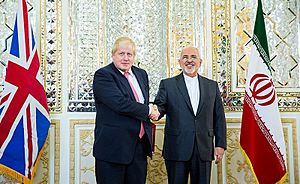
On 2 April 2015, a framework for a nuclear deal was announced. Iran agreed to limit its nuclear program for at least ten years and allow international checks. In return, international penalties would be lifted.
Nuclear Agreement
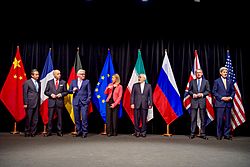
On 24 November 2013, the Geneva interim agreement, also called the Joint Plan of Action, was signed. This agreement froze parts of Iran's nuclear program for a short time. In exchange, some economic penalties on Iran were reduced. This was a step towards a long-term agreement.
Other Important Issues
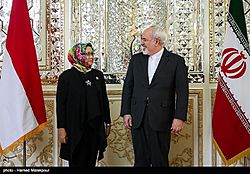
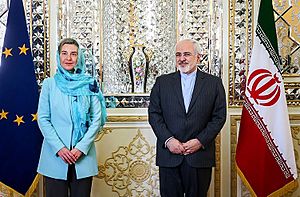
In April 2015, Zarif was asked about the detention of a Washington Post reporter in Iran. He stated that Iran does not imprison people for their opinions.
Zarif criticized the U.S. involvement in the conflict in Yemen. He said the United States should be held responsible for harm caused to people.
In February 2019, Zarif met with Hezbollah leader Hassan Nasrallah in Beirut. Nasrallah thanked Zarif for Iran's support. Zarif confirmed Iran's strong support for Lebanon.
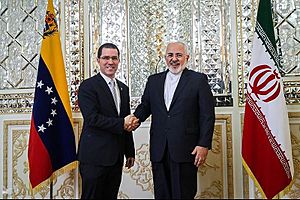
In April 2019, Zarif said he had suggested a prisoner exchange deal to the U.S. government in 2018. He added that the U.S. needed to show it was serious before any talks.

Zarif spoke against the 2019 Turkish military action in Syria. He saw it as a violation of Syria's independence. However, regarding the U.S. withdrawal from Syria, Zarif said the U.S. was an "unimportant occupier." He also said Iran would help solve tensions between Syria and Turkey.
Zarif called the peace agreement between Israel and the United Arab Emirates a betrayal of countries in the Middle East.
Resignation as Foreign Minister
Zarif announced his resignation as Foreign Minister on 25 February 2019, using Instagram. He apologized for any shortcomings during his time in office.
One reason for his resignation was reportedly his exclusion from meetings with Syrian President Bashar al-Assad during a visit to Tehran. However, President Rouhani rejected Zarif's resignation two days later. Qasem Soleimani, a powerful military leader, also rejected it, saying Zarif was key to foreign policy. So, Zarif continued in his role.
Sanctions
In July 2019, the United States placed sanctions on Zarif. The U.S. called him an "illegitimate spokesperson for Iran." The European Union expressed regret about this decision.
Leaked Audiotape
On 25 April 2021, a three-hour audio recording of a conversation between Zarif and an economist was published. In the tape, Zarif criticized the Islamic Revolutionary Guard Corps (IRGC) and its commander, Qasem Soleimani. He also claimed that former U.S. Secretary of State John Kerry told him that Israel had attacked Iranian targets in Syria many times. The Iranian foreign ministry did not deny the tape's authenticity.
Vice President for Strategic Affairs
Zarif supported Masoud Pezeshkian in the 2024 Iranian presidential election. After Pezeshkian won, Zarif was asked to help choose ministers for the new government.
In August 2024, President Pezeshkian appointed Zarif as Vice President in charge of strategic affairs. However, Zarif resigned shortly after due to disagreements about who should be in the government. He felt that promises to include more women, young people, and different ethnic groups were not kept. But on August 27, Zarif announced he would return to the position. He resigned for a second time on March 2, 2025, and this resignation was accepted on April 15, 2025.
Accolades
- Iran National Industry Champions Festival's ‘Champion of Champions of Diplomacy’: 2013
- KhabarOnline's ‘Face of The Year’: 2013
- TIME's ‘100 Most Influential People in the World’ (2): 2014, 2015
- Global Risk Insights' ‘Person of the Year in Political Risk’: 2015
- Chatham House Prize: 2016 (shared with John Kerry)
National Orders
| Ribbon | Distinction | Country | Date | Location | Ref |
|---|---|---|---|---|---|
| Order of Merit and Management, 1st Class | 8 February 2016 | Tehran | |||
| Grand Cross of Order of the Condor of the Andes | 26 August 2016 | La Paz | |||
| Order of Friendship | 10 September 2018 | Tehran |
Personal Life
Mohammad Javad Zarif is married and has two children. Both his daughter, an interior decorator, and his son, a marketing consultant, were born in the United States. He met his wife in 1979. They married in Iran but moved to New York a few weeks later. Besides his native Persian, he also speaks English very well.
See also
 In Spanish: Mohamad Yavad Zarif para niños
In Spanish: Mohamad Yavad Zarif para niños
- List of foreign ministers in 2017
- List of current foreign ministers
- Iran–United States relations during the Obama administration
- Iran–United States relations during the first Trump administration
- Iran–United States relations during the Biden administration


